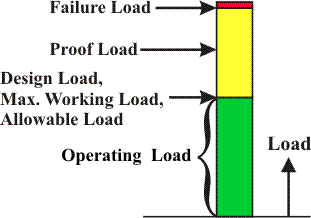|
» Proof Testing
For many structural systems, it is important to test
them to prove that they work before they are put into service.
PROOF TESTING is especially necessary when
the system or construction methods are new, the structure is difficult
to analyze, or when the failure of the system can cause significant damage,
especially in human life. The load at which the system is tested - the
Proof Load, Pp - is greater than the Working Load,
PD but less than the Failure Load, Pf.
|

|







